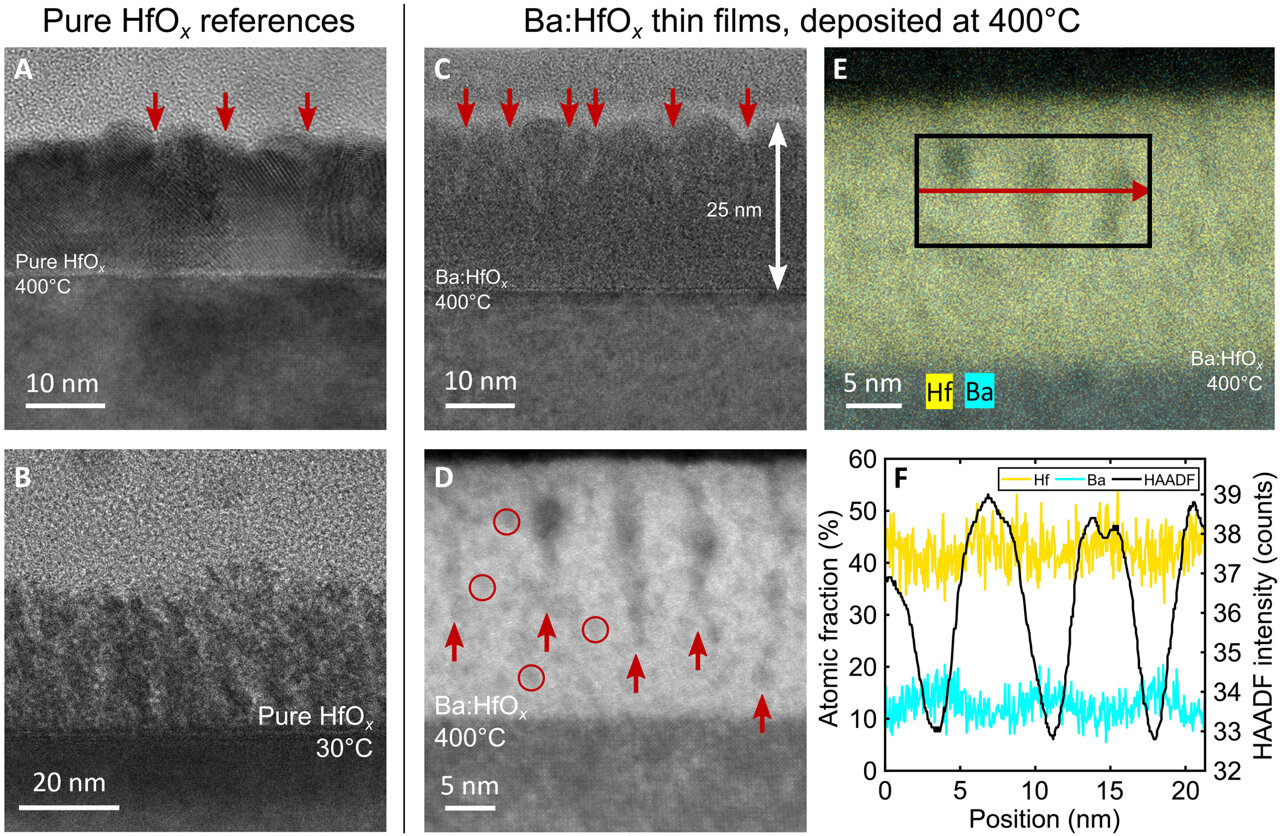
Cross-sectional TEM images and energy-dispersive x-ray measurements from high-angle annular dark-field scanning TEM for different thin films. (A) Pure HfOx deposited at 400°C. Clear crystallites are visible in the film; red arrows indicate some of the grain boundaries. (B) Pure HfOx deposited at 30°C. While these films are not polycrystalline like pure HfOx deposited at 400°C, neither are they as uniform as the composite films presented in (C). (C) The thin films which resulted in stable electrical performance are amorphous or nanocrystalline. Some pillar-like structures can be discerned, indicated by red arrows. The addition of Ba to the films clearly leads to material uniformity by suppressing crystallization. (D) High-angle annular dark-field scanning TEM (HAADF-STEM), zoomed in on some of the pillars. In addition, darker nanoparticles can be discerned throughout the films; four randomly chosen particles are marked by red circles. (E) HAADF-STEM image to indicate the area scanned for EDX and the elemental distribution of Hf and Ba. (F) Line scan EDX results acquired from the area indicated in (E). The dark areas in the HAADF-STEM image contain more Ba than the brighter ones. The ratio between Ba and Hf in the pillars is about 0.25 to 0.33, consistent with the Rutherford backscattering analysis discussed later.
Credit: Science Advances (2023). DOI: 10.1126/sciadv.adg1946
Researchers have developed a new design for computer memory that could both greatly improve performance and reduce the energy demands of internet and communications technologies, which are predicted to consume nearly a third of global electricity within the next ten years.
These materials can work like a synapse in the brain: they can store and process information in the same place, like our brains can
Markus Hellenbrand
The researchers, led by the University of Cambridge, developed a device that processes data in a similar way as the synapses in the human brain. The devices are based on hafnium oxide, a material already used in the semiconductor industry, and tiny self-assembled barriers, which can be raised or lowered to allow electrons to pass.
This method of changing the electrical resistance in computer memory devices, and allowing information processing and memory to exist in the same place, could lead to the development of computer memory devices with far greater density, higher performance and lower energy consumption. The results are reported in the journal Science Advances.
Our data-hungry world has led to a ballooning of energy demands, making it ever more difficult to reduce carbon emissions. Within the next few years, artificial intelligence, internet usage, algorithms and other data-driven technologies are expected to consume more than 30% of global electricity.
“To a large extent, this explosion in energy demands is due to shortcomings of current computer memory technologies,” said first author Dr Markus Hellenbrand, from Cambridge’s Department of Materials Science and Metallurgy. “In conventional computing, there’s memory on one side and processing on the other, and data is shuffled back between the two, which takes both energy and time.”
One potential solution to the problem of inefficient computer memory is a new type of technology known as resistive switching memory. Conventional memory devices are capable of two states: one or zero. A functioning resistive switching memory device however, would be capable of a continuous range of states – computer memory devices based on this principle would be capable of far greater density and speed.
“A typical USB stick based on continuous range would be able to hold between ten and 100 times more information, for example,” said Hellenbrand.
Hellenbrand and his colleagues developed a prototype device based on hafnium oxide, an insulating material that is already used in the semiconductor industry. The issue with using this material for resistive switching memory applications is known as the uniformity problem. At the atomic level, hafnium oxide has no structure, with the hafnium and oxygen atoms randomly mixed, making it challenging to use for memory applications.
However, the researchers found that by adding barium to thin films of hafnium oxide, some unusual structures started to form, perpendicular to the hafnium oxide plane, in the composite material.
These vertical barium-rich ‘bridges’ are highly structured, and allow electrons to pass through, while the surrounding hafnium oxide remains unstructured. At the point where these bridges meet the device contacts, an energy barrier was created, which electrons can cross. The researchers were able to control the height of this barrier, which in turn changes the electrical resistance of the composite material.
“This allows multiple states to exist in the material, unlike conventional memory which has only two states,” said Hellenbrand.
Unlike other composite materials, which require expensive high-temperature manufacturing methods, these hafnium oxide composites self-assemble at low temperatures. The composite material showed high levels of performance and uniformity, making them highly promising for next-generation memory applications.
A patent on the technology has been filed by Cambridge Enterprise, the University’s commercialisation arm.
“What’s really exciting about these materials is they can work like a synapse in the brain: they can store and process information in the same place, like our brains can, making them highly promising for the rapidly growing AI and machine learning fields,” said Hellenbrand.
The researchers are now working with industry to carry out larger feasibility studies on the materials, in order to understand more clearly how the high-performance structures form. Since hafnium oxide is a material already used in the semiconductor industry, the researchers say it would not be difficult to integrate into existing manufacturing processes.
Original Article: New type of computer memory could greatly reduce energy use and improve performance
More from: University of Cambridge
The Latest Updates from Bing News
Go deeper with Bing News on:
Scomputer memory
- More efficient molecular motor widens potential applications
Light-driven molecular motors were first developed nearly 25 years ago at the University of Groningen, the Netherlands. This resulted in a shared Nobel Prize for Chemistry for Professor Ben ...
- More efficient molecular motor widens potential applications
Light-driven molecular motors were first developed nearly 25 years ago at the University of Groningen, the Netherlands. This resulted in a shared Nobel Prize for Chemistry for Professor Ben Feringa in ...
- Nathan Derr
The Derr lab also pursues synthetic biology and the application of molecular motors to engineered nanoscale transport devices. ** = undergraduate co-authors Derr ND. Interactions of multiple dynein ...
- New Cancer Treatment Approach: Innovative Molecules That Vibrate and Destroy Cancer Cells
The method uses aminocyanine molecules, which have long been employed in bioimaging due to their synthetic ... surpasses previous molecular machines known as Feringa-type motors, as per their ...
- Molecular motors
Synthetic molecular motors represent a promising alternative approach to gain further insight into the principles by which biological motors function. Better understanding the mechanisms of ...
Go deeper with Bing News on:
Computer memory
- Take a trip down macOS memory lane with these web-based retro versions of Apple's operating system - and yes, they can run Doom
You can also access a saved hard drive that will back up any files you create on your computer locally, and drag any files from your desktop into the web browser, creating a file called “Outside World ...
- ChatGPT now has a ‘memory’
ChatGPT now has a ‘memory’ - New update marks major step in AI abilities, and should allow it to be more personalised ...
- China Has a Controversial Plan for Brain-Computer Interfaces
China's brain-computer interface technology is catching up to the US. But it envisions a very different use case: cognitive enhancement.
- Samsung reports 10-fold increase in profit as AI drives rebound for memory chips
Revenue rose by nearly 13, driven by higher prices for memory chips and robust sales of its flagship Galaxy S24 smartphones.
- Police’s Computer-Generated Image Is Giving People Real Pete Buttigieg Vibes
Transportation Secretary Pete Buttigieg is the latest public figure whose (potential) lookalike is being sought by police in England. Investigators in the southeast town of Tunbridge Wells on Monday ...










